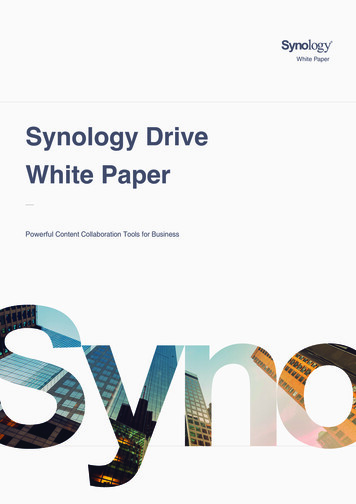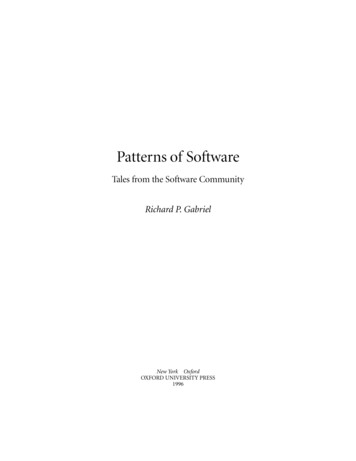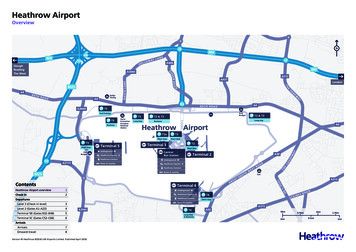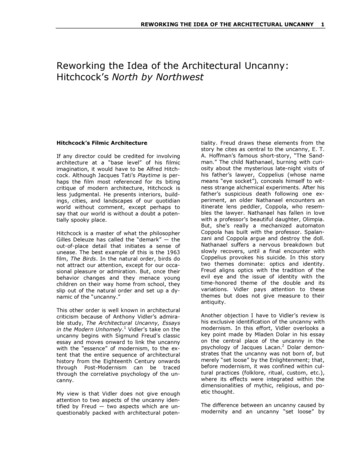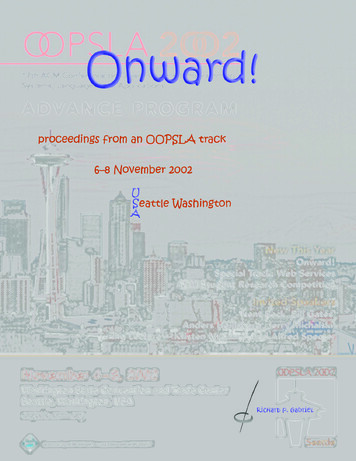
Transcription
Onward!A Track at OOPSLA 2002Seattle, WashingtonNovember 6–8, 2002The Onward! Track contains technical and philosophicalpapers describing new paradigms or metaphors incomputing, new thinking about objects, newframings of computational problems or systems,and new technologies. Papers in the Onward!Track aren’t aimed at advancing the state of theart—they’re aimed, instead, at altering orredefining the art by proposing a leap forward—or sideways—for computing.ChairRichard P. GabrielSun Microsystems, Inc.Program CommitteeGeoff CohenCap Gemini Ernst & YoungPierre CointeL'Ecole des Mines de NantesDave ThomasBedarra Corporation and Carleton University
Authors have retained all rights to theirrespective papers.Adjunct material copyright Richard P. Gabriel.Dream Songs Press 2002
The Onward! ProgramWednesday, 6 November 2002 13:30–15:00Convention Center—Ballroom 6DNew Models for Software IThis session sets the stage for the Onward! track by presenting two extreme points in the discussion on howto move forward with software: Autonomic computing, at one end, is being both researched and designedinto existing systems today, while the metaphor of magic is intended to stimulate people to think far beyondthe walls of the box and the academy.A Vision of Autonomic ComputingJeffrey O. KephartIBMkephart@us.ibm.comAutonomic Computing is a new approach to coping with the rapidly growing complexity of operating andintegrating computing systems. This paper elaborates on the vision of autonomic, or self-managing computing. The goal is not to present a well-articulated architecture. Instead, the author speculates about generalarchitectural features that might typify autonomic computing systems of the future, and uses this as a basisfor discussing several challenging scientific and engineering issues that need to be addressed in order to realize the vision of autonomic, or self-managing computing.MagicDave WestNew Mexico Highlands Universitydwest@cs.nmhu.eduAssume an obverse version of Clarke's insight: “If a technology is not magical, it is insufficiently advanced.”Computing and software development are clearly not magical even though some applications, especially incinema special effects, certainly convey magical impressions. The central question of this essay—can we usemagic as a metaphor to re-evaluate and redefine the theory and practice of computing? Or, stated slightly differently, can magic provide a metaphor for opening a new frontier in the investigation and solution of the coreproblems confronted by software developers and computing professionals in today's world?
Wednesday, 6 November 2002 15:30–17:00Convention Center—Ballroom 6DPanel: Biologically Inspired SoftwareSteven HofmeyrCompany 51steve@company51.comJeffrey O. KephartIBMkephart@us.ibm.comDave WestNew Mexico Highlands Universitydwest@cs.nmhu.eduBoth biologists and computing researchers need metaphors and concepts to understand how complex, largesystems work, even if that understanding is merely statistical or otherwise non-predictive. This panel exploresthe question of furthering computing and organizing computations by looking at the concepts found in biology, used by biologists, and required by biologists.
Wednesday, 6 November 2002 19:30–21:00Convention Center—Exhibit Hall 4BKeynote: What’s Next?Jerry MichalskiSociateTechnology is not neutral. It reflects the objectives and mental models of those who design it, the businessimperatives of the times and the interactions of those who use it. By tracing the history behind some oftoday's critical technologies, then describing the dynamics between the major forces in the business marketand the market of ideas, Jerry will tackle questions such as: Why does it seem that innovation is at a standstill, despite much emphasis on corporate innovation? What role do our assumptions about capitalism, intellectual property, assets and scarcity have in our continuing evolution? How will programming quickly/slowly, in the large/in the small, with closed/open models and withhighly structured/unstructured, organic approaches play out? Where should technology developers place their energies?
Thursday, 7 November 2002 10:30–12:00Convention Center—Ballroom 6DNew Models for Software IIThis session looks at new ways of thinking about software and how to build it, through the lenses of postmodernism and just-in-time manufacturing processes. Both these papers are concerned with how people dealwith software, not simply with its technologies.Notes on Postmodern ProgrammingJames NobleVictoria University of Wellington, New Zealandkjx@mcs.vuw.ac.nzRobert BiddleVictoria University of Wellington, New Zealandrobert@mcs.vuw.ac.nzWhat is postmodern computer science? How is programming related to computer science? The authors havewritten, “Let us create a new guild of programmers without the class-distinctions that raise an arrogant barrier between programmers and computer scientists! Let us desire, conceive, and create the new program ofthe future together. It will combine design, user-interfaces, and programming in a single form, and will oneday rise towards the heavens from the hands of a million workers as the crystalline symbol of a new and coming faith.”Principles of Lean ThinkingMary PoppendieckPoppendieck.LLCmary@poppendieck.comIn the 1980's, a massive paradigm shift hit the factories throughout the US and Europe. Mass productionand scientific management techniques from the early 1900's were questioned as Japanese manufacturing companies demonstrated that “Just-in-Time” was a better paradigm. The widely adopted manufacturing conceptscame to be known as “Lean Production”. When appropriately applied, Lean Thinking is a well-understoodand well-tested platform upon which to build agile software development practices.
Thursday, 7 November 2002 13:30–15:00Convention Center—Ballroom 6DNew Programming ConstructsThis session presents two practical ideas derived from challenging common assumptions. The first is theresult of questioning the assumption that a server is necessary to coordinate cooperating networks, and thesecond questions a commonsense design rule.Many-to-Many InvocationAlan KaminskyRochester Institute of Technologyark@cs.rit.eduHans-Peter BischofRochester Institute of Technologyhpb@cs.rit.eduMany-to-Many Invocation (M2MI) is a new paradigm for building collaborative systems that run in wirelessproximal ad hoc networks of fixed and mobile computing devices. M2MI is useful for building a broad rangeof systems, including multiuser applications (conversations, groupware, multiplayer games); systems involving networked devices (printers, cameras, sensors); and collaborative middleware systems.Problematic Encapsulation in High-Risk SystemsDaniel DvorakJet Propulsion Laboratory, California Institute of Technologydaniel.dvorak@jpl.nasa.govOne of the most common metaphors in OOAD clashes with the physics of the real world. Moreover, thisclash isn’t obvious in everyday systems—it only becomes obvious in a category of systems called “high risksystems.” The metaphor is that of designing an object model that is isomorphic to the hardware aggregationhierarchy, i.e., decomposition by subsystem and device, with encapsulated state. Hardware units seem likeobvious candidates for objects; the paper shows how this ‘obvious’ metaphor breaks down and can lead to amessy design. The paper uses examples from NASA space missions involving control of spacecraft and Marsrovers as examples of high-risk systems.
Thursday, 8 November 2002 12:00–13:00Convention Center—Rooms 602–604Panel: New Programming Constructs Beyond Inheritance, Patterns, and Notation:What's left?Geoff CohenCap Gemini Ernst & Young Center for Business Innovationgeoff.cohen@cgey.comWilliam R. CookAllegis Corporationwilliam@allegis.comRobert FilmanAmes Research Center, NASArfilman@mail.arc.nasa.govThere hasn’t been much beyond incremental improvements to programming languages for about the last 10years. We see implementation advances, variants on encapsulation and composition, notation, process, patterns, and a steady diet of types, types, and more types. This panel tries to uncover what we haven’t thoughtof yet.
The Onward! Papers
A Vision of Autonomic ComputingJeffrey O. KephartIBM ResearchYorktown Heights, NY 10598kephart@us.ibm.comOctober 29, 2002AbstractIn October, 2001, IBM released a manifesto [1] that defined autonomic computing, a new approach to coping with the rapidly growing complexity of integrating, configuring and operating computing systems. This article elaboratesfurther on IBM’s vision of autonomic computing. We speculate about generalarchitectural features that might typify autonomic, or self-managing, systemsof the future, and use this as a basis for discussing several challenging scientificand engineering issues that need to be addressed in order to realize this vision.Our goal is to motivate the academic and industrial research communities toaddress these fundamental problems.1IntroductionOn March 8, 2001, Paul Horn, Senior Vice President of IBM Research, announcedIBM’s commitment to autonomic computing—a fundamentally new approach to coping with the rapidly growing complexity of operating and integrating computing systems [2]. This was soon followed in April of that year by the announcement of ProjecteLiza, an initiative to build self-managing capabilities into IBM supercomputers andmainframes. Then, on October 15, 2001, IBM released a manifesto that justifiedthe need for autonomic computing, and described in broad terms several characteristics that autonomic computing systems of the future will possess [1]. The manifestoobserved that the main obstacle to further progress in the information technologyindustry is not a slowdown in Moore’s law. Rather, it is the inexorability of Moore’slaw that has led us to the verge of a software complexity crisis. Over the last fewdecades, programmers have fully exploited a four- to six-orders-of-magnitude increasein computational power, producing ever more sophisticated and functional softwareapplications and environments—some weighing in at tens of millions of lines of code,and requiring skilled I/T professionals to install, configure, tune, and maintain them.But the difficulty of managing today’s computing systems goes well beyond theadministration of individual software environments. The need to integrate several heterogeneous environments into corporate-wide computing systems introduces a whole1
new level of complexity. With the rapid growth of the Internet and electronic commerce, interconnectedness is now being extended beyond company boundaries bybusinesses seeking to integrate their business processes with those of their tradingpartners, compounding the problems of system management and integration to thepoint where it can take several person-years of effort. We appear to be approachingthe limits of human capability, yet the march towards increased interconnectivity andintegration appears to be rushing ahead unabated. Complexity could turn the dreamof pervasive computing, with its vision of trillions of computing devices connected tothe Internet [3], into a nightmare.Past crises in software complexity have often been overcome by programming language innovations, such as high-level languages, structured programming, and objectoriented programming, that have extended the size and complexity of systems thatarchitects can design. But sole reliance on further innovations in programming methods will not get us though the present crisis. As systems are becoming ever moreinterconnected with an increasingly diverse set of other systems and environments,architects are less and less able to pre-plan intricate interactions among system components, leaving such issues to be resolved at run time. This places on system administrators and system integrators a burden that neither are capable of assuming,due to a growing labor shortage1 and the growing gap between the inherent difficulty of system management and the fixed limits of human capability. If we continueon our present course, installing, configuring, optimizing, maintaining, and mergingmassive, complex, and heterogeneous computing systems will become too difficultfor even the most skilled I/T workers, as will the task of making sufficiently quick,decisive reponses to rapid streams of changing and conflicting demands.We are left with only one option: to create computing systems that manage themselves. More specifically, we must create computing systems that configure, heal, optimize and protect themselves in accordance with high-level behavioral specificationsfrom human administrators.IBM has coined the phrase autonomic computing to represent its vision of howthe world will rise to this new grand challenge. According to the Oxford EnglishDictionary, there is no essential difference between the primary definitions of “autonomic” and “autonomous.” Both words mean “self-governing.” But by choosingautonomic, we are deliberately playing on the biological connotation. The autonomicnervous system governs many of our involuntary functions, including our heart rate,our respiratory rate, our blood’s sugar and oxygen levels, our body temperature, ourdigestion, and the dilation of our pupils. It frees our conscious brain from the burdenof having to deal with these vital but lower-level functions.The autonomic nervous system is emblematic of many complex natural systemsthat are self-governing. In essence, life on Earth is a concentric series of levels of aggregation, each level comprising many interacting, autonomous, self-governing components, each of which may be composed of large numbers of interacting, autonomous,self-governing components at the next level down. Consider the enormous range in1The I/T labor shortage in the United States alone is expected to grow from roughly 450,000 in2001 to 600,000 in 2002, despite the weak economy [4].2
scale that starts with molecular machines within cells, then up to individual cells,increasingly complex multi-cellular organisms, social groups such as hives and herds,and beyond to the entire world ecosystem. In the case of humans, parallel branchesof this hierarchy extend beyond individuals to tribes, societies or markets, and beyond these to the entire world socio-economy. It is entirely within the purview ofautonomic computing to seek inspiration in social and economic systems as well.Thus, in our use of the term autonomic computing, we are really expressing botha desire to find new paradigms for achieving self-governance of massive and complex computing systems and a belief that inspiration for those new paradigms canbe found in a variety of natural systems, of which the autonomic nervous systemis representative. We are encouraged by prior successes in applying biological andeconomic principles to problems in computer science, including anti-virus [5] andintrusion detection systems [6] patterned after the immune system, adaptive decentralized network routing algorithms inspired by the social intelligence of ants [7], andmarket-based distributed computation and problem solving approaches [8].In its original manifesto, IBM set forth the grand challenge of creating selfmanaging computing systems, and suggested that nature may hold the key to theirdesign. But noone believes that this challenge can be met by any one organization.It will take a concerted, long-term, worldwide effort by researchers in diverse fields tomeet this challenge. The purpose of this article is to paint a somewhat more detailedpicture of what autonomic computing systems might look like, discuss in generalterms how they might function, and to use this as a basis for outlining some of themajor challenges that we face in designing them and understanding their behavior.Specifically, in section 2 we elaborate on the notion of self-management, and presentsome scenarios that illustrate the behavioral characteristics that will typify autonomiccomputing systems. Then, in section 3, we discuss a set of architectural considerations that serve as the basis for discussions in sections 4 and 5 of some fundamentalengineering and scientific issues that need to be tackled if we are to realize our visionof autonomic computing.2Perspectives on Self-ManagementThe essence of autonomic computing systems is self-management. This section presentsa few different perspectives on the nature of self-management, beginning with presentday views, then speculating about how the notion of self-management may evolve overthe coming years, and finally culminating in a series of vignettes that depicts howpeople may experience autonomic systems several years hence.Ever since the launch of its autonomic computing initiative, IBM has been citing four aspects of self-management: self-configuration, self-healing, self-optimization,and self-protection. This view of self-managment naturally reflects a concern with specific present-day problems that make system administration particularly difficult andburdensome. Let us expand a bit upon each of these facets of self-management: Self-configuration. Today, installing, configuring and integrating large complex systems can be quite challenging, time-consuming, and error-prone—even3
for experts. Large web sites or corporate data centers are typically a haphazardaccretion of servers, routers, databases, and other technologies on several different platforms from several different vendors, the full configuration and functionality of which cannot be grasped by any single human mind. It can takemonths of effort by teams of expert programmers to make significant changes tosuch systems (such as installing a major e-commerce application such as SAP,or merging two such systems into one).Autonomic systems will be able to configure themselves automatically in accordance with high-level policies (representing business-level objectives, for example) that specify what is desired, not how it is to be accomplished. Adding anew component will be like adding a new cell to the body, or a new individualto a large population. When it is introduced to the system, it will incorporateitself seamlessly (even if it is of a new type), and the rest of the system willadapt to its presence automatically, to the mutual benefit of the system andthe new component. Self-optimization. Today, large complex middleware (e.g. WebSphere) ordatabase (e.g. Oracle or DB2) systems have dozens or even hundreds of tunable parameters. The performance of the system is strongly and nonlinearlydependent on the settings of these parameters, and is also strongly dependenton the usage conditions, so that an untuned system with parameters set to theirdefault values can perform very poorly. Retuning to keep up with changes inusage patterns is very daunting, and therefore undertaken much less frequentlythan would be optimal. The complexity of database tuning, for example, isindicated by the number of books written on the topic—a quick survey of online bookstores turns up 24 on Oracle database tuning alone [9, 10]. New bookshave to be written continually, as the performance metrics and the tuning knobschange with each release level of the same product. One author [11] has commented that “If you write a technical book about Oracle, it will be out of dateby the time you’ve finished writing it, and within a year of publication it willbe 20% misleading, inappropriate, or just plain wrong.” The same holds forany system of comparable complexity and functionality. As if this were not badenough, consider that such systems are often integrated with one another, andtherefore performance tuning of one large subsystem can have unanticipatedeffects on the system as a whole.Autonomic systems will continually seek ways to improve their operation, identifying and seizing opportunities to make themselves more efficient in terms ofperformance or cost—just as muscles become stronger through exercise, and thebrain modifies its circuitry during the course of learning. They will achieve thisby monitoring, experimenting with, and tuning their own parameters, and bymaking appropriate choices about insourcing or outsourcing functions. Self-healing and self-protection. Today, problem determination is a huge,important, and difficult enterprise. IBM and other I/T vendors have largedepartments devoted to identifying, tracing, and determining the root cause4
of errors and failures in large, complex computing systems. The most seriouscustomer problems can sometimes take teams of programmers several weeksto diagnose and fix, and sometimes the problem disappears mysteriously aftera sufficient amount of trial and error, without any satisfactory diagnosis everbeing made.Autonomic computing systems will be self-healing—capable of detecting, diagnosing, and repairing localized problems arising from bugs or failures in softwareor hardware. They will also be self-protecting in at least two different senses.First, they will defend the system as a whole against large-scale, correlatedproblems arising from malicious attacks or cascading failures that remain uncorrected by self-healing measures. Second, they will anticipate potential problems(perhaps based on early reports from sensors or components) and take steps toavoid them, or at least to mitigate their effect.2In early versions of autonomic systems, these four aspects of self-management maybe treated as distinct from one another, with different product teams creating individual solutions that address each issue separately. Ultimately, however, we believe thatautonomic systems will be built in such a way that these aspects of self-managementwill be emergent properties of a general autonomic architecture. As a consequence,the present-day distinctions among these properties will begin to blur. For example,self-protection, self-healing, and some aspects of self-optimization may well mergeinto more encompassing notions of self-maintenance and robustness: Self-maintenance and robustness. In a manner analogous to that of theirbiological namesakes, autonomic systems will maintain and adjust their operation in the face of changing workloads, demands and external conditions, and inthe face of hardware or software failures of innocent or malicious origin. Thusself-healing and self-protection may simply be more extreme manifestations ofthe system’s continual efforts to accommodate and adapt to change. Autonomicsystems will display another aspect of self-maintenance—proactively seeking toupgrade their function by finding, verifying and applying the latest softwareupdates.Another trend that we foresee is the gradual adoption of automation in autonomicsystems over time. The usual historical pattern of automation will be followed. Atfirst, automated functions will merely collect information, and help aggregate it inways that support decisions by human administrators. Later, they will serve in anadvisory capacity, suggesting possible courses of action, and offering to execute thesesuggested actions at the press of a button. As the automation technologies improve,and as humans’ faith in those technologies grows in tandem (perhaps lagging a yearor two behind), humans will entrust autonomic systems with making (and acting2Somayaji and Forrest[12] have developed an interesting example of automated protection calledprocess homeostasis, in which abnormal Linux processes are delayed in proportion to the degree oftheir abnormality. This technique slows down processes that are potentially damaging to the system,helping it to cope with malicious attacks and propagating failures.5
upon) more and more of the lower-level decisions. In effect, the roles will be reversed:humans will now serve as advisors to the autonomic system, rendering relativelyless frequent and higher-level decisions that are carried out automatically via morenumerous, lower-level decisions and actions taken by the system itself. Over time,human input will be ever more high-level and infrequent.Thus far, we have focussed mainly on the benefits of autonomic computing tosystem administrators. In order to portray how end users may experience selfmanagement in relatively sophisticated autonomic systems of the future, we concludethis section with a series of vignettes. The vignettes focus on the higher levels of theautonomic computing hierarchy—from departmental computing systems ranging upto the automated e-business interactions among e-businesses—simply because this iswhere people will experience autonomic systems most directly.Now let us listen in on some conversations among co-workers during an ordinaryday at MachineCuisine.biz. . .9am, by the coffee machineKyle: The new mainframe and a couple new servers arrived yesterdayafternoon, so I plugged them in.Kayla: Ah, so that’s why the system seems a little faster this morning!11am, in Tyler’s officeTyler: I’m worried that I won’t be able to finish my Talking ToasterRoaster design by this afternoon. My Designer app has been really slowthis morning.Taylor: Hmmm. . . I heard that Kyle plugged in some new machines lastnight. Maybe some of the basic system services migrated to the newhardware or upgraded themselves. I bet your app is just a little outof sync right now—it probably needs to be reconfigured or upgraded orsomething. Did you ask it what’s wrong?Tyler: Oh yeah, let’s see. . .right—my app says it wants me to let itupgrade one of its components and re-tune itself. Oh, look—here’s amessage it sent me last night asking for permission. Arrggh! Why didn’tI read my e-mail?Taylor: Geez—you’re still using e-mail notification? Whatever—justclick on OK.Tyler: I know, Taylor—I’ve done this plenty of times before. Al. . .right,it says it’s done. Let’s see. Yup, it’s back to normal—actually, it seems alot faster than before. Cool! This’ll put the Talking Toaster-Roaster backon track!Taylor: Great. Umm. . . why don’t you change the software upgradeoption in your personal profile from manual to automatic?6
Tyler: I like to wait a couple days to make sure there aren’t problems.Wasn’t there some kind of bug last year?Taylor: Oh, you’re probably thinking of the one that happened whenthey put in the new payroll system. That was no big deal. The automaticregression tester discovered the discrepancy a few minutes after the newsystem was installed, so the old system kicked back in immediately and ranfor a few hours until they fixed the bug. I’m surprised you remember. . .Lunchtime, in the cafeteriaBritney: Does that burrito really need a whole bottle of tabasco sauce?Whitney: It only looks like a burrito—it sure doesn’t taste like one. Soanyway. . .did you hear the good news? Our department is probably goingto meet its budget after all.Britney: You’re kidding! I thought the earthquake blew our databaseservices costs.Whitney: It did, but last week another provider opened a new 20-acredatabase services facility in Canada. A bunch of our databases decidedto migrate there. Prices have already dropped below last month’s levels,and we’re even seeing slightly better response times.Britney: Terrific!Whitney: Now if we could only get our chef to migrate to Canada. . .3pm, by the coffee machineKyle: SAP announced a major upgrade this morning.Kayla: Yeah, I heard. How’s it going?Kyle: Oh, fine. They’ve run our acceptance suite and the bleeding edgeusers have already been switched over. Everyone else will follow theirusual switchover profiles.Kayla: [Snickering.] It’ll probably take Tyler an hour to press all thoseOK buttons.Kyle: Maybe just 10 minutes—his fingers have had lots of practice!7pm, at a local restaurantTyler: My boss loves the Toaster-Roaster—thanks a lot for helping methis morning.Taylor: No problem—glad she likes it. Hey—did you hear that somehackers broke into our eFrigerator Service today and deleted all of theFridgeWidgets?7
Tyler: Oh no—I bet our customers are pretty mad! And we’ll probablyhave to pay Food Emporium and Safeway some pretty stiff service outagepenalties.Taylor: Not really—they hardly even noticed. Our sentinels immediately noticed that the FridgeWidgets weren’t responding, so they told ourbackup e-utility to handle the load for a few minutes while a fresh setof FridgeWidgets looked around for a new e-utility provider. They foundone with a good reputation, and they negotiated a great price and serviceguarantee.Tyler: At least for the next couple weeks, until the new provider tries toraise its prices on us!Taylor: Don’t worry—our FridgeWidgets are pretty hard-nosed, and theycan always find a cheaper e-utility if they have to.These vignettes3 illustrate several aspects of self-management that will be common to autonomic systems and their elements at all levels, from software or hardware components to enterprises to electronic markets: self-upgrading, self-optimizing,and self-healing applications, self-migrating databases, self-installing mainframes andservers, and enterprises that automatically and seamlessly outsource their businessprocesses.As we have stated, we believe that ultimately these common aspects of selfmanagement will emerge from a common set of architectural principles and conceptsthat will apply broadly across many different types of applications, and at manydifferent levels, ranging from individual computational elements like disk drives toentire automated businesses that sell information goods and services to one another.The next section provides a broad outline of some basic architectural principles thatappear capable of providing a basis for autonomic systems.3Architectural ConsiderationsThus far, we have painted a picture of how autonomic computing systems mightbehave, but we have given only vague hints as to how they might be built. In thissection, we describe in the most generic terms some architectural thoughts and designpatterns that appear promising to us. Our primary purpose is not to define a detailedarchitecture, but to provide the necessary framework for discussing what we believeto be some of the most important a
IBM kephart@us.ibm.com Autonomic Computing is a new approach to coping with the rapidly growing complexity of operating and integrating computing systems. This paper elaborates on the vision of autonomic, or self-managing comput-ing. The goal is not to present a well-articulated architecture. Instead, the author speculates about general
